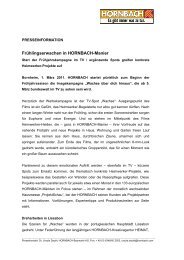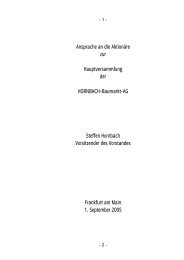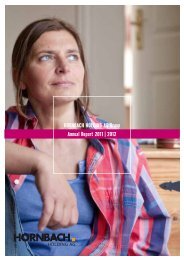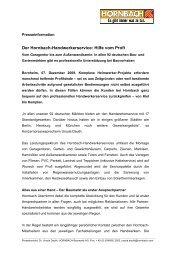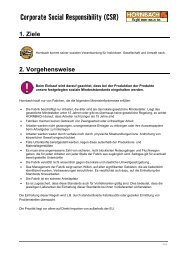Hornbach-Baumarkt-AG Group
PDF, 3,6 MB - Hornbach Holding AG
PDF, 3,6 MB - Hornbach Holding AG
- No tags were found...
You also want an ePaper? Increase the reach of your titles
YUMPU automatically turns print PDFs into web optimized ePapers that Google loves.
NOTES TO THE CONSOLIDATED FINANCIAL STATEMENTS Explanatory notes on the principles and methods applied in the consolidated financial statements 105<br />
Provisions and accrued liabilities<br />
Provisions are recognized for uncertain obligations to third parties where such are likely to result in a future<br />
outflow of resources. Provisions are stated at the expected settlement amount, having accounted for all<br />
identifiable risks, and are not offset against recourse claims. If the overall effect is material, non-current<br />
provisions are measured at present value discounted to the end of the respective terms. Provisions for pending<br />
losses and onerous contracts are recognized if the contractual obligations in connection with stores<br />
rented from third parties are higher than the expected economic benefits. In the case of accrued liabilities,<br />
the date and level of the respective liability are no longer uncertain.<br />
Financial instruments<br />
Financial instruments are contracts which result in a financial asset at one company and a financial liability<br />
or equity instrument at another company. On the one hand, these include primary financial instruments such<br />
as trade receivables and payables, financial receivables and financial liabilities. On the other hand, they<br />
also include derivative financial instruments, such as options, forward exchange transactions, interest<br />
swaps and currency swaps. Customary purchases and sales of foreign exchange are generally recognized as<br />
of the transaction date. Customary purchases and sales of all other financial assets are generally recognized<br />
as of the settlement date, i.e. on the date at which the asset is delivered. Upon initial recognition, financial<br />
instruments are recognized at cost. This corresponds to their fair value.<br />
Financial assets are basically derecognized once the contractual rights to payment have expired. Furthermore,<br />
financial assets are derecognized when the contractual rights to payment, and thus all significant risks and<br />
rewards or powers of disposal over these assets, have been assigned. Financial liabilities are derecognized<br />
once they have been settled, i.e. once the liability has been repaid, cancelled or has expired.<br />
Primary financial instruments<br />
In accordance with IAS 39 “Financial Instruments: Recognition and Measurement”, asset-side financial<br />
instruments are subsequently measured at amortized cost, at cost, or at fair value. Primary financial instruments<br />
constituting liabilities are measured at amortized cost. The HORNBACH-<strong>Baumarkt</strong>-<strong>AG</strong> <strong>Group</strong> has so<br />
far not made any use of the option of classifying financial assets or financial liabilities as measured at fair<br />
value through profit or loss.<br />
Financial assets are classified as available for sale pursuant to IAS 39. They are measured at fair value,<br />
where this can be reliably determined, and otherwise at cost. Investments and prepayments for financial<br />
assets are recognized at cost, as there is no active market for these items and their fair values cannot be<br />
reliably determined at reasonable expense. These exclusively relate to equity instruments.<br />
Receivables and other assets (except derivatives) are carried at amortized cost or at present value, if lower.<br />
Value reductions are stated to account for all identifiable risks. These are determined on the basis of individual<br />
risk assessments and depending on the maturity structure of overdue receivables. Specific cases of<br />
default lead to the receivable in question being derecognized. Impairment accounts are maintained for trade<br />
receivables and the financial assets recognized under other receivables and assets. Amounts from impairment<br />
accounts are derecognized, with a corresponding charge to the carrying amount of the impaired assets,<br />
in cases such as when insolvency proceedings against the debtor have been completed, or when the receivable<br />
is deemed irretrievably lost.<br />
Cash and cash equivalents include cash on hand and short-term deposits with maturity dates of less than<br />
three months. These items are measured at amortized cost.



